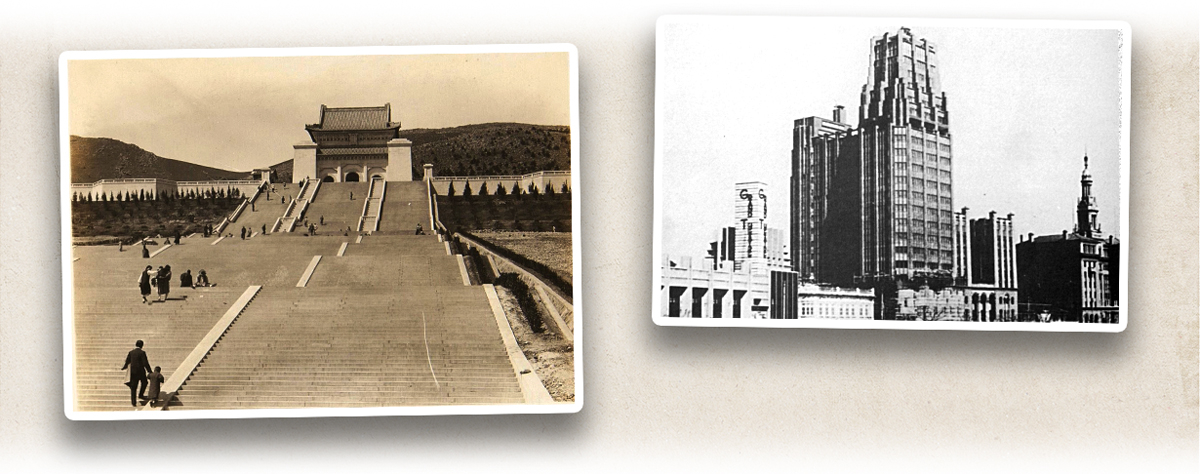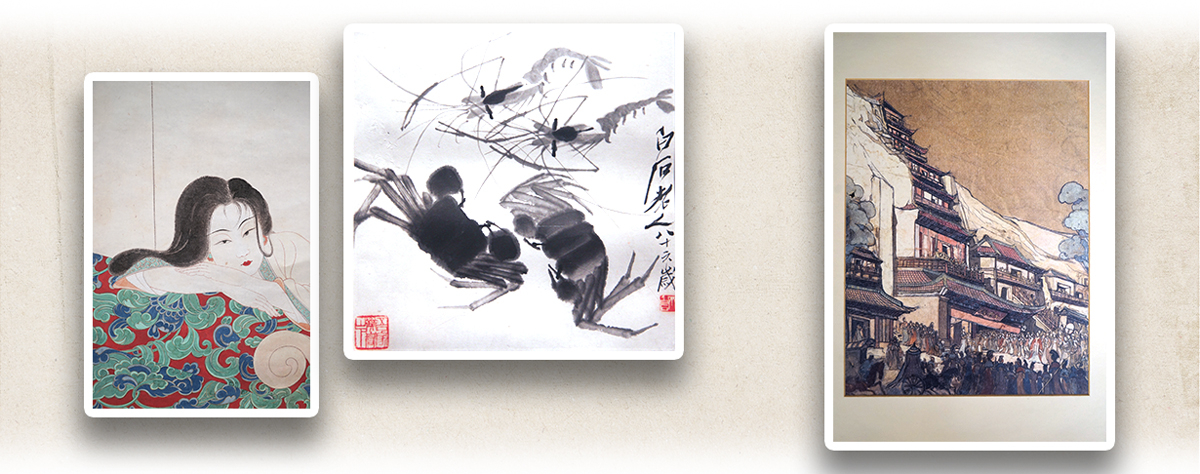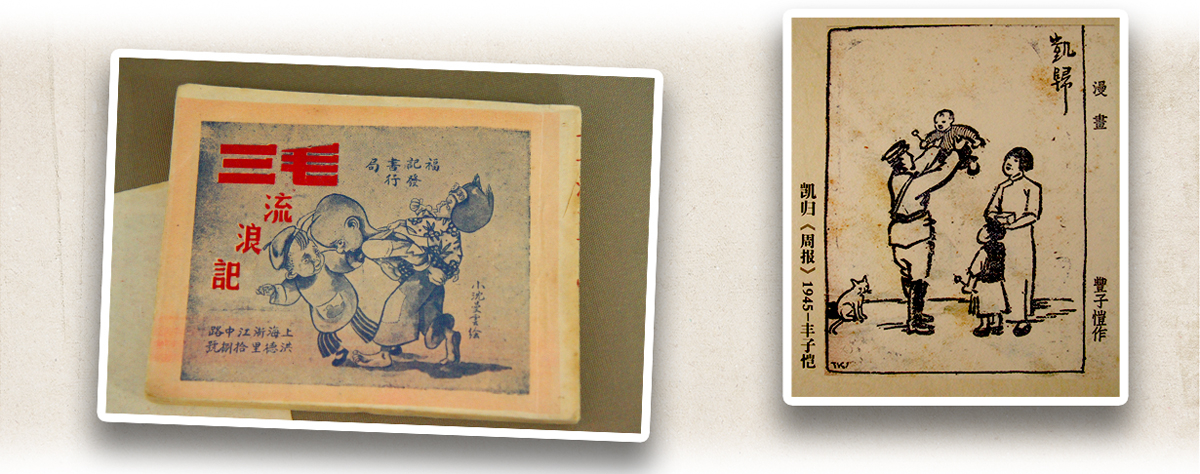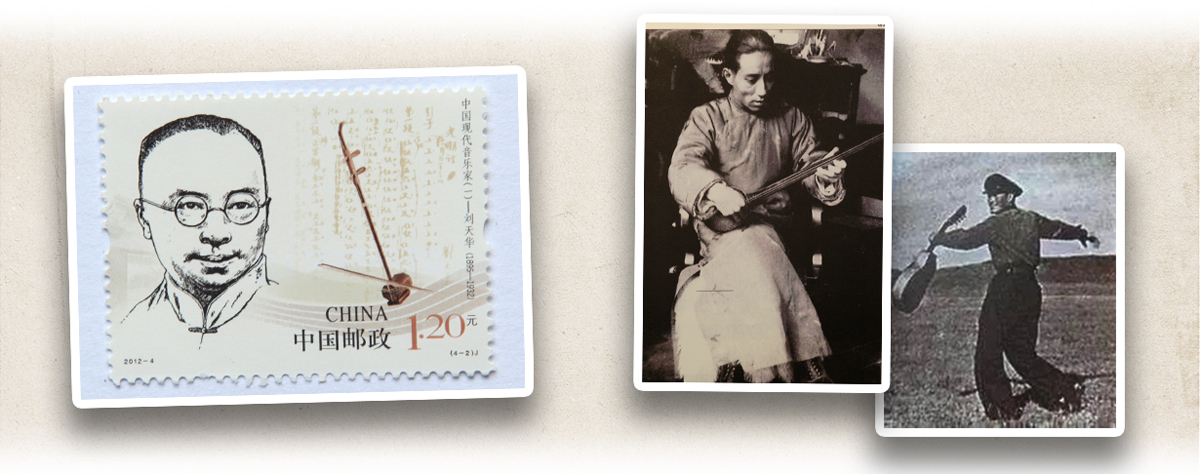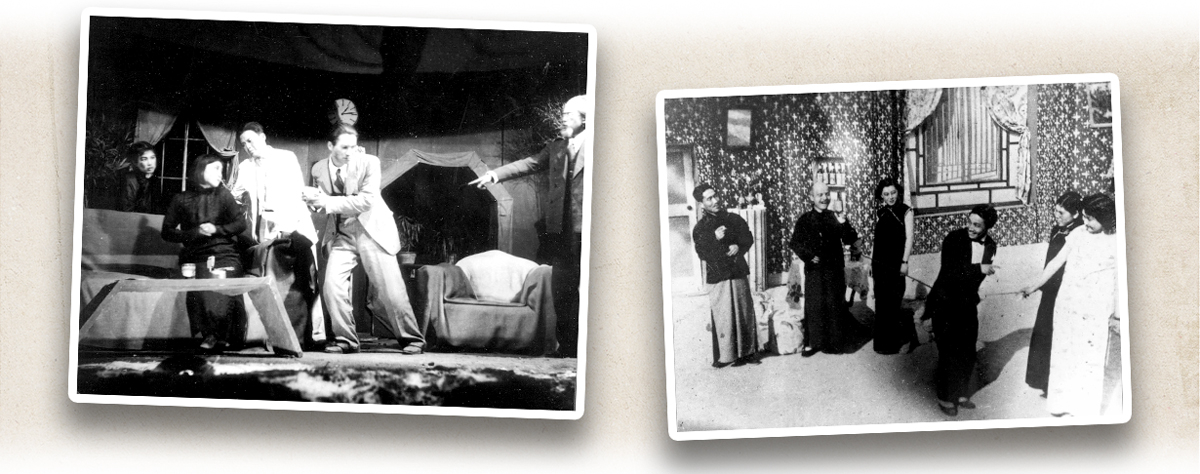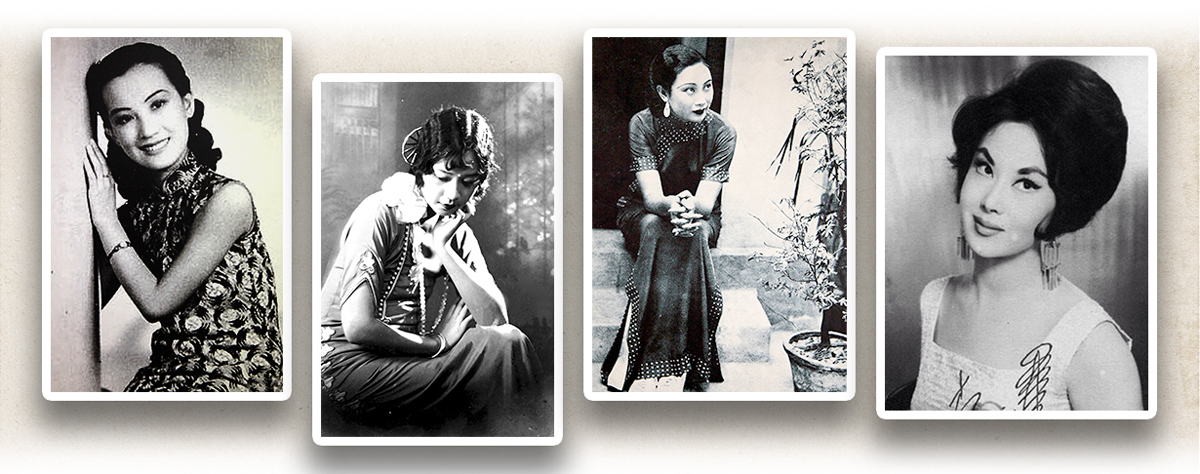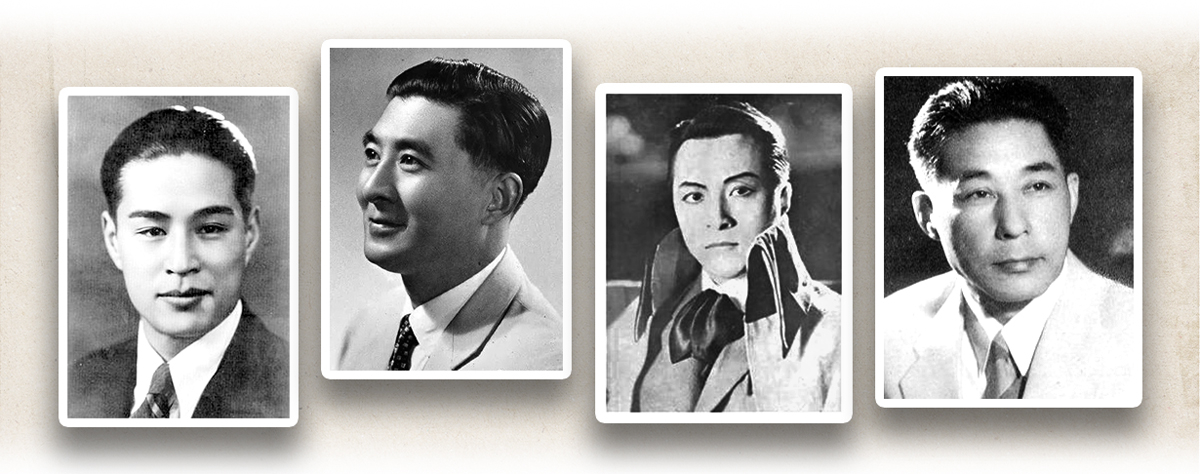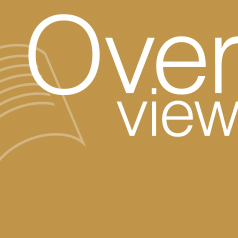In the Republican period, China’s art world blossomed from painting and architecture, to dance and music, opera, drama, and film. Due to spatial limitations, only a brief introduction can be given here.
At that time, there were many renowned painters skilled in traditional Chinese painting, oil painting, or cartoons, including Li Shutong (李叔同), Liu Haisu (劉海粟), Zhang Daqian (張大千), Huang Binhong (黃賓虹), Pu Xinyu (溥心畲), Xu Beihong (徐悲鴻), Feng Zikai (豐子愷), Qi Baishi (齊白石), Zhang Leping (張樂平), Ye Qianyu (葉淺予), Li Kuchan (李苦禪), Li Keran (李可染), Chen Banding (陳半丁), Fu Baoshi (傅抱石), Pan Tianshou (潘天壽), Wu Guanzhong (吳冠中), Wu Zuoren (吳作人), Wu Changshuo (吳昌碩), Jiang Zhaohe (蔣兆和), Lin Fengmian (林風眠), and Chang Shuhong (常書鴻). As for music and dance, Liu Tianhua (劉天華), Hua Yanjun (華彥鈞, Abing﹝阿炳﹞), and Wang Luobin (王洛賓) carried on the legacy of Chinese folk music, particular by immortalising the song At a Faraway Place (《在那遙遠的地方》); meanwhile Nie Er (聶耳), Xian Xinghai (冼星海), and He Luting (賀綠汀) combined Western and Chinese styles for inspirational new songs like March of the Volunteers (《義勇軍進行曲》), Guerrillas’ Song (《游擊隊歌》), and Yellow River Cantata (《黃河大合唱》). Modern Chinese dance developed significantly over the period thanks to contributions from those in close contact with European, American, and Soviet dance circles, such as Yu Rongling (裕容齡), Li Bozhao (李伯釗), Li Jinhui (黎錦暉), Wu Xiaobang (吳曉邦), and Dai Ailian (戴愛蓮). Buildings during that period combined Chinese and Western elements as well. Some examples include, in Nanjing (南京): Sun Yat-sen Mausoleum, the Presidential Palace, the National Great Hall, the National Central Museum (now Nanjing Museum); in Shanghai (上海): the Waibaidu Bridge (外白渡橋), Shanghai Park Hotel, Peace Hotel, the Paramount, Grand Theatre, and the Great World; in Beiping (北平, now Beijing﹝北京﹞): Liang Qichao Tomb (梁啟超墓), Sun Yat-sen Memorial Hall in Xiangshan Park (香山); in Guangzhou (廣州): the Memorial Museum of Generalissimo Sun Yat-sen’s Mansion, Sun Yat-sen Memorial Hall, and the former site of the Whampoa Military Academy (黃埔軍校).
The artistic achievements during the Republican era are also evident in its traditional operas and the new realm of motion pictures. As for Peking Opera (京戲), Mei Lanfang (梅蘭芳), Cheng Yanqiu (程硯秋), Shang Xiaoyun (尚小雲), and Xun Huisheng (荀慧生) were collectively known as the “four great dan (旦, female role) artists” of Peking Opera, while Ma Lianliang (馬連良), Zhou Xinfang (周信芳), and Li Shaochun (李少春) were great xu (鬚, middle-aged male role) artists. There were also famous martial art actors like Gai Jiaotian (蓋叫天). Besides Peking Opera, local operas thrived as well, such as Yue (Shaoxing﹝紹興﹞) Opera (越劇), Cantonese Opera (粵劇), Yu (Henan Province﹝河南﹞) Opera (豫劇), Ping Opera (評劇), and Huangmei Opera (黃梅戲). As for straight plays, modern drama masterpieces emerged one after another, including Cao Yu’s (曹禺) Thunderstorm (《雷雨》), Sunrise (《日出》), and The Wilderness (《原野》); Guo Moruo’s (郭沫若) Cherry Blossom (《棠棣之花》) and Qu Yuan (《屈原》); Chen Baichen’s (陳白塵) Sheng Guan Tu (《升官圖》), and Xia Yan’s (夏衍) Under Shanghai Eaves (《上海屋簷下》). Films spread from the West into China during the Republican era, where they took root and grew. The Republic had its own film stars. For example, Ruan Lingyu (阮玲玉), Hu Die (胡蝶), Zhou Xuan (周璇), Li Lihua (李麗華), Ouyang Shafei (歐陽莎菲), Jin Yan (金焰), Zhao Dan (趙丹), Jin Shan (金山), Wei Heling (魏鶴齡), and Sun Daolin (孫道臨). Some of the most acclaimed films of the period were Twin Sisters (《姊妹花》), New Women (《新女性》), Song of the Fishermen (《漁光曲》), Song at Midnight (《夜半歌聲》), Children of Troubled Times (《風雲兒女》), Street Angel (《馬路天使》), Crossroads (《十字街頭》), 800 Heroes (《八百壯士》), and The Spring River Flows East (《一江春水向東流》).
|
|
Music composition during the Republican period was closely related to current situation, while film art was a new genre. What is a brief introduction of both? |
|
|
See answer below. |
Sun Yat-sen Mausoleum in Nanjing and Shanghai Park Hotel were well-known buildings in the Republican era. In 1929, the Nationalist Government of the Republic of China (ROC) held the ceremony of the Grand Funeral of Dr Sun Yat-sen (孫中山), moving his coffin from Beiping to the Sun Yat-sen Mausoleum in Nanjing. Established in 1934, Shanghai Park Hotel, the tallest building outside the United States, was known as the “Tallest Building of the Far East”.
The ROC witnessed the emergence of many great painters and masterpieces. From the left: the Portrait of a Lady Holding a Fur Coat (detail) by Zhang Daqian (張大千), Shrimps and Crabs (《蝦蟹》) by Qi Baishi, and Nine Floors of Dunhuang (《九層樓》) by Chang Shuhong, which depicts the Mogao Caves (莫高窟). Stepping beyond the world of art, some painters’ works had an important influence in academic domains. For example, Chang’s paintings about Dunhuang (敦煌) provided substantial materials for the development and research of Dunhuang Studies.
The ROC saw significant development in Chinese cartoons. Left: the 1935 serial picture story Wanderings of Sanmao (《三毛流浪記》) by Zhang Leping. Sanmao’s stories reflect the misery of homeless children in Shanghai, which caused a big stir and provided materials for relevant artistic creation in later decades. Right: Triumphant Return (《凱歸》), drawn in 1945 by Feng Zikai (豐子愷). This cartoon depicts a soldier reuniting with his families after the victory of the Total War of Resistance Against Japanese Aggression.
The Republican period was a golden era for modern Chinese music, producing many well-known musicians and compositions. From the left: a stamp commemorating the ROC musician Liu Tianhua; the blind musician Hua Yanjun playing the erhu (二胡); Wang Luobin, known as the “Father of Northwest Folk Songs” and “West China’s Singing King”, holding a guitar and dancing on the grasslands of Qinghai Province (青海). Many classic musical pieces were created during the Republican period, such as Hua’s The Moon’s Reflection on the Second Spring (《二泉映月》) and Wang’s At a Faraway Place remain popular to this day.
During the Republican period, dancers combined Chinese and Western styles to push Chinese dance arts to a new level. From left to right: Yu Rongling, Dai Ailian, and Wu Xiaobang during performance.
Significant progress was also made in traditional Chinese operas as they took the international stage during the ROC. In particular, the Peking Opera artist Mei Lanfang achieved international renown. Left: The Drunken Beauty (《貴妃醉酒》) performed by Mei in Shanghai in December 1914. Right: the American master of comedy Charles Spencer Chaplin meeting Mei during his visit to China on 3 March 1936.
During the Republican period, new dramas shone on the stage, especially the works of Cao Yu. The photos show Cao’s famous dramas being performed in 1941, Thunderstorm (left) and Sunrise (right).
The film industry throve at that time. Many film stars became major public idols, including (from left to right): Zhou Xuan, Ruan Lingyu, Hu Die, and Li Lihua.
Among the ROC’s female stars, the most influential was surely singer and actress Zhou Xuan. In the 1930s-40s, she made a name for herself in both acting and music, praised as the “Golden Voice”, “Singing Queen”, and “Movie Queen”. She starred in 43 films and sang more than 200 original songs. Zhou’s classic songs, such as When Will You Return (《何日君再來》), Four Seasons Song (《四季歌》), The Wandering Songstress (《天涯歌女》), and Shanghai Nights (《夜上海》) won universal acclaim in their time. They were later covered by many other famous singers. Taiwan’s Teresa Teng Li-chun (鄧麗君), for example, covered several of Zhou’s great pieces. Zhou’s legendary life has been adapted into films, TV plays, and songs. For example, there was a Hong Kong TV series Song Bird (《天涯歌女》) featuring her life. In that production, Adia Chan Chung-ling (陳松伶) played Zhou and sang the theme song of the same title, which was based on the original tune but in Cantonese.
Four male film stars of the ROC (from left to right): Jin Yan, Zhao Dan, Jin Shan, and Wei Heling.
The ROC left us with many classic films, whose quality were able to stand the test of time.
Left: the film Street Angel produced by Mingxing Film Company (明星影片公司) in 1937, written and directed by Yuan Muzhi (袁牧之), with cast members including Zhao Dan, Wei Heling, Zhao Huishen (趙慧深), and Zhou Xuan.
Middle: the film The Wandering Songstress produced by Guotai Pictures Company (國泰影業公司) in 1941, written and directed by Wu Cun (吳村), with cast members including Zhou Xuan, Bai Yun (白雲), and Murong Wan’er (慕容婉兒).
Right: Eight War-Torn Years (《八年離亂》), part one of the 1947 film The Spring River Flows East, produced by United Photoplay Service (聯華影藝社), written and directed by Cai Chusheng (蔡楚生) and Zheng Junli (鄭君里), with cast members including Bai Yang (白楊), Tao Jin (陶金), Shu Xiuwen (舒繡文), Shangguan Yunzhu (上官雲珠), and Wu Yin (吳茵).
|
|
Music composition during the Republican period was closely related to current situation, while film entered the scene as a new genre. What is a brief introduction of both? |
|
|
The Republican period had songs that befitted the times. There were also pieces for supporting the War of Resistance and expressing emotions. Well-known songs included the Farewell Song (《送別》, often sung upon the parting of graduates) by Li Shutong (or Master Hong Yi﹝弘一法師﹞); How Could I Help Thinking of Her written by Liu Bannong (劉半農) and composed by Zhao Yuanren (趙元任); Song of the Fishermen written by An E (安娥) and composed by Ren Guang (任光); Graduation Song (《畢業歌》) and March of the Volunteers written by Tian Han (田漢) and composed by Nie Er (聶耳); Exile Trilogy (《流亡三部曲》) including Along the Songhua River (《松花江上》) written and composed by Zhang Hanhui (張寒暉); Song at Midnight written by Tian Han and composed by Xian Xinghai; When Will You Return written by Huang Jiamo (黄嘉謨) and composed by Liu Xue’an (劉雪庵); The Great Wall Ballad (《長城謠》) written by Pan Jienong (潘孑農) and composed by Liu Xue’an; The Sword March (《大刀進行曲》) written and composed by Mai Xin (麥新); The Wandering Songstress written by Tian Han and composed by He Luting; Guerrillas’ Song written and composed by He Luting; On the Taihang Mountains (《在太行山上》) written by Gui Taosheng (桂濤聲) and composed by Xian Xinghai; Yellow River Cantata written by Guang Weiran (光未然) and composed by Xian Xinghai; At a Faraway Place and Kangding Love Song (《康定情歌》) written and composed by Wang Luobin; and Falling is Nothing (《跌倒算甚麼》) written by Lu Yong (綠永) and composed by Shu Mo (舒模). During the Republican period, well-known movies included the Sing-song Girl Red Peony (《歌女紅牡丹》, directed by Zhang Shichuan﹝張石川﹞, starring Hu Die, Wang Xianzhai﹝王獻齋﹞, Xia Peizhen﹝夏佩珍﹞, Gong Jianong﹝龔稼農﹞, etc.); Fate in Tears and Laughter (《啼笑因緣》, directed by Zhang Shichuan, starring Hu Die, Zheng Xiaoqiu﹝鄭小秋﹞, Tan Zhiyuan﹝譚志遠﹞, Xiao Ying﹝蕭英﹞, Gong Jianong, Yan Yuexian﹝嚴月嫻﹞, Wang Xianzhai, etc.); Twin Sisters (written and directed by Zheng Zhengqiu﹝鄭正秋﹞, starring Hu Die, Zheng Xiaoqiu, Xuan Jinglin﹝宣景琳﹞, etc.); Three Modern Women (《三個摩登女性》, directed by Bu Wancang﹝卜萬蒼﹞and written by Tian Han, starring Jin Yan, Ruan Lingyu, Chen Yanyan﹝陳燕燕﹞, Lai Cheuk-Cheuk﹝黎灼灼﹞, etc.); New Women (directed by Cai Chusheng and written by Sun Shiyi﹝孫師毅﹞, starring Ruan Lingyu and Zheng Junli﹝鄭君里﹞); Song of the Fishermen (directed by Cai Chusheng, starring Wang Renmei﹝王人美﹞, Han Langen﹝韓蘭根﹞, Luo Peng﹝羅朋﹞, etc.); Plunder of Peach and Plum (《桃李劫》, directed by Ying Yunwei﹝應雲衛﹞, starring Yuan Muzhi, Chen Bo’er﹝陳波兒﹞, Tang Huaiqiu﹝唐槐秋﹞, Zhou Boxun﹝周伯勳﹞, etc.); Song at Midnight (directed by Ma-Xu Weibang﹝馬徐維邦﹞, starring Jin Shan, Hu Ping﹝胡萍﹞, etc.); Children of Troubled Times (directed by Xu Xingzhi ﹝許幸之﹞and written by Tian Han, Xia Yan﹝夏衍﹞, and Sun Shiyi, starring Yuan Muzhi, Wang Renmei, Tan Ying﹝談瑛﹞, Lu Luming﹝陸露明﹞, etc.); Street Angel (written and directed by Yuan Muzhi, starring Zhou Xuan, Zhao Huishen, Zhao Dan, etc.); Crossroads (directed by Shen Xiling﹝沈西苓﹞, starring Zhao Dan, Bai Yang, etc.); 800 Heroes (directed by Ying Yunwei, starring Yuan Muzhi, Chen Bo’er, Hong Hong﹝洪虹﹞, etc.); Emperor’s Lover (《千里送京娘》, directed by Wen Yimin﹝文逸民﹞and written by Ye Yifang﹝葉逸芳﹞, starring Guan Hongda﹝關宏達﹞, Zheng Junli, Li Lihua, He Bin﹝賀賓﹞, Yang Liu﹝楊柳﹞, etc.); Dan Feng Chao Yang (《丹鳳朝陽》, directed by Gao Lihen﹝高梨痕﹞, starring Wang Danfeng﹝王丹鳳﹞, Jiang Ming﹝姜明﹞, etc.); Far Away Love (《遙遠的愛》, written and directed by Chen Liting﹝陳鯉庭﹞, starring Zhao Dan, Qin Yi﹝秦怡﹞, etc.); The Spring River Flows East (directed by Cai Chusheng and written by Zheng Junli, starring Bai Yang, Tao Jin, Shu Xiuwen, and Shangguan Yunzhu); and the Crows and Sparrows (《烏鴉與麻雀》, directed by Zheng Junli and written by Chen Baichen﹝陳白塵﹞, starring Zhao Dan, Wu Yin, Shangguan Yunzhu, Sun Daolin, Li Tianji﹝李天濟﹞, Huang Zongying﹝黃宗英﹞, etc.). In 1945, artists of The Lu Xun Academy of Arts (魯迅藝術學院) in Yan’an (延安) collectively produced the opera The White Haired Girl (《白毛女》), which was written by He Jingzhi (賀敬之) and Ding Yi (丁毅), composed by Ma Ke (馬可), Zhang Lu (張魯), Qu Wei (瞿維), Li Huanzhi (李煥之), Xiang Yu (向隅), Chen Zi (陳紫), and Liu Chi (劉熾), and directed by Wang Bin (王濱), Wang Dahua (王大化), and Shu Qiang (舒強), starring Wang Kun (王昆), Ling Zifeng (凌子風), and Chen Qiang (陳強). |
Source of most photos used in this feature piece: Fotoe.





